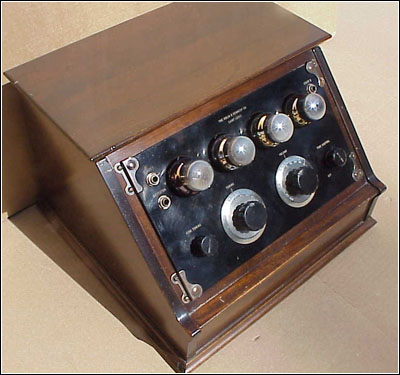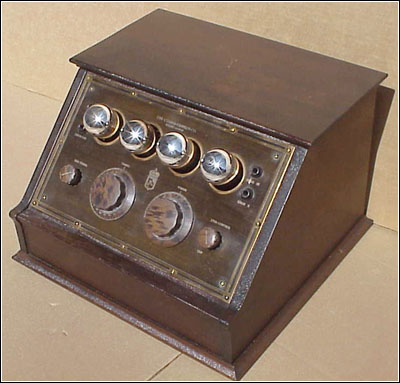Of Old Radios And Related Items--Published Monthly
The Kennedy Model VI
BY DAVE CROCKER
web edition
Longtime collector Dave Crocker knows excellent craftsmanship when he sees it. Here he tells us about the two versions of the Kennedy Model VI, which he considers eminently collectible. (Editor)
If you've ever owned an early Kennedy battery receiver, or even opened the top lid of one and peeked inside, you'll understand why they were known as "The Royalty of Radio." The chassis of these sets were built of the highest quality components with superb craftsmanship.
Just lift the cover of a Kennedy Model 110 or 220 and you will see what I'm talking about. You won't believe the work that went into those fantastic bank-wound coils. These two sets, along with the Model 281, were manufactured by the Colin B. Kennedy Company, in either San Francisco, California, or in St. Louis, Missouri. Later, the company moved all radio production to the St. Louis plant.
The Model VI Earlier Version
So much for company history; let's get down to radio details. At one time or another, I've owned, almost all of the early Kennedy receivers, but I just recently learned that there were two versions of the 1924 Model VI. This model, which the company referred to as the Type 420, is a 4-tube radio with all four tubes exposed on the front, slanted panel. It uses three stages of audio amplification and one stage of regenerative detection. Nothing new here. But how it is built and how it looks is its strong point.
However, two distinct versions using similar cabinets were produced. The earlier version, Serial # 38539, has a slant panel of thick Bakelite, highly polished and fastened to the cabinet by four metal corner brackets. See Figure 1. The two main dials, one for tuning and the other for volume control, have a black Bakelite knob and a nickel-plated, sometimes frosted, dial skirt. Both are scribed 100-0.
A smaller, fluted, Bakelite knob on the right side of the panel is labeled "Tube Control," (a rheostat). A similar knob on the left side is labeled "Fine Tuning." Both are scribed with arrows.
Figure 1. The earlier version of the Kennedy Model VI with Bakelite panel.On the left side of the first tube are two jacks. These are labeled "Stage 1" and "Detector." Just to the right of tube #4 are two more jacks; one is labeled "Stage 3" and below that is "Stage 2." So much for the controls.
The chassis of this earlier Model VI, shown in Figure 2 (see print version), has a plethora of metal-tagged battery wires coming out the rear. Some are attached to the four outside rear binding posts, as shown in Figure 3 (see print version), and some to the internal Fahnestock clips inside the cabinet. There was also a 3-tube version, known as the Model V, with a similar Bakelite panel used in the Model III portable and the Model X large cabinet-style radio.
It is my understanding that this same chassis and panel were used in the 4-tube Kennedy Model XV "Sheraton" cabinet model. This larger set had doors for batteries and a bi-fold closing cover for the panel.
The Model VI Later Version
Now for the later Model VI set, which is shown in Figure 4. This version, Serial #58576, sports a unique brass, metal panel with a painted wood-grain finish. The controls are located similar to the earlier type, except that the two main tuning dials are entirely fabricated of molded red-rubber, or "mud." The left dial is scribed 100-0 and 100-200. The right dial is scribed 100-0 only. There is a large, Kennedy crest etched between the two. The same molded material is used on the two outer control knobs with arrows. The cabinets used are identical to the 1923 Model V and 1925 Model 20. All four have lift-top lids.
This later VI was the first Kennedy set to feature the metal panel. This metal panel style was also used on the later 5-tube, single vernier dial Model 20 and the 5-tube, 2-dial Model XXX window set.
There are slight chassis design differences with the earlier and later Model VIs. The later version, shown in Figure 5 (see print versio), has larger internal binding posts attached to the chassis top. There are no outside binding posts, as shown in Figure 6 (see print version). The tube sockets are of a different style, with fluted sides.
Could it have been that Kennedy planned this "new style" brass panel for its 1924 radios, but first used up surplus, old-style Bakelite panels like those on the earlier VI? Radio manufacturers were just beginning to shy away from "lab equipment-looking" apparatus and move to the more pleasing style having a "furniture" appearance? The lady of the house would agree.
Figure 4. The later version of the Kennedy Model VI with the brass metal panel.More Kennedy History
In my opinion, the Kennedy Vs and VIs were beautiful sets of pleasing design and size. The two Models X and XI are nice, too, but rather cumbersome in size. The 5-tube Model XV is just too dark and massive -- the perfect size and design is not there. With the coming of the 1-dial Model 20, the Kennedy look turned drab, and its diminished desirability as a collector item reflects that.
Colin B. Kennedy continued manufacturing radios up until 1932. There were a few plain-looking table models -- a "Coronet" tombstone, a cathedral, and some floor models, but the quality appeal and craftsmanship that set Kennedy apart from most other sets was no more. The classic Kennedy design era was over.
Do yourself a favor. Lift the lid and feast your eyes on the workmanship on any of the Kennedys of pre-1925 vintage. You'll see why these sets are so desirable to collect.
Dave Crocker, a graphic artist and a semi-retired member of the A.R.C. staff, has been collecting radios for over 40 years. Many of these years have been spent researching and collecting radios made by the Crosley Radio Company.
|
[Free Sample] [Books, etc., For Sale] [Subscribe to A.R.C./Renew] [Classified Ads] [Auction Prices] [Event Calendar] [Links] [Home] [Issue Archives] [Book Reviews] [Subscription Information] [A.R.C. FAQ]URL = http://www.antiqueradio.com/Oct09_Crocker_Kennedy6.html Copyright © 1996-2009 by John V. Terrey - For personal use only. Last revised: September 30, 2009. For Customer Assistance please contact ARC@antiqueradio.com or call (866) 371-0512 toll free Antique Radio Classified |

